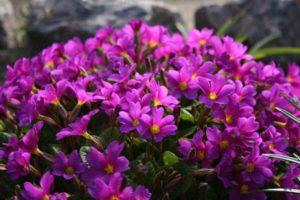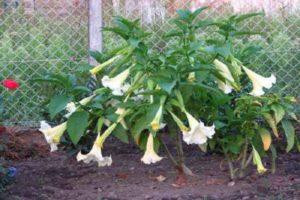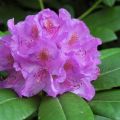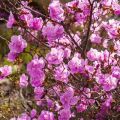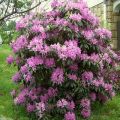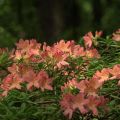Description and characteristics of subclasses of rhododendron Rasputin, planting and care
Among flowering shrubs, Rasputin's rhododendron has no equal in beauty and attractiveness. This evergreen plant will decorate the area near the house thanks to its large flowers, the range of which ranges from delicate purple to deep purple. It is important to know all the rules of planting and care, as well as other useful information about this luxurious shrub.
Brief definition
Rhododendron Rasputin belongs to hybrid varieties of evergreen shrubs from the Heather family. It is distributed in the Caucasus, the Himalayas, North America and China.
Detailed description
This rhododendron variety is distinguished by its bright and attractive appearance. An evergreen shrub with strong, straight stems has an average height of one and a half meters.
Rasputin rhododendron flowers, rather large in size, are presented in dense inflorescences. They harmoniously combine a delicate purple hue with dark purple or raspberry blotches on the upper petals. The flowering period begins during the transition period from spring to summer.
Large leaves are characterized by an oblong shape, dense texture with gloss. In length, they reach 12-15 centimeters. On the outside it is dark in color, and on the bottom it is light. They turn brown before hibernation.
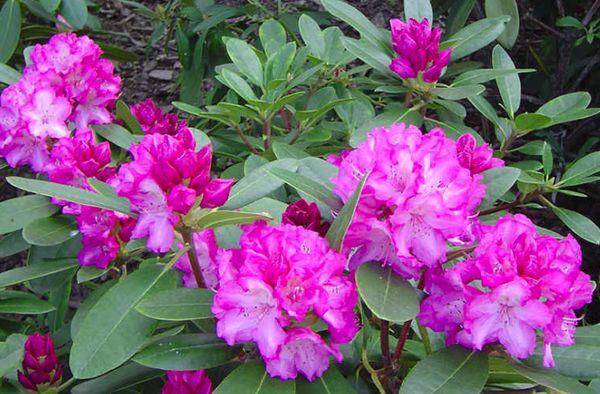
The fruits ripen by autumn. They look like light brown bolls filled with small seeds. The root of the shrub is compact in size and comes to the surface.
History of origin
Rhododendron Rasputin and other hybrid varieties of evergreen rhododendrons were developed in the 20th century as a result of the labors of breeders.
Distinctive features
This type of rhododendron is distinguished by the darkest and deepest colors. The bush is characterized by sprawling free growth. Flowers appear on it every year in large numbers and last a long time. This variety is unpretentious and able to grow even in alkaline soils. The frost resistance of each subspecies is different.
Subsort
Each of the sub-varieties has unique characteristics and benefits.
Boleslav the Brave
This variety got its name in honor of the son of the Polish king Mieszko. It is distinguished by a truly royal appearance - with a dense strong crown and abundant flowering. It reaches 1.5 meters in height and 1 meter in width.
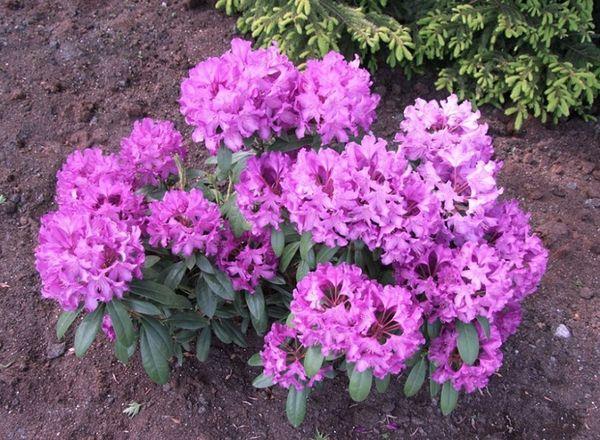
The plant has dense leaves with an oblong convex shape. Large dark purple flowers are decorated with an expressive yellow pattern. Each inflorescence has approximately 10-12 flowers. Boleslav the Brave blooms twice a year - at the end of May, and then at the end of summer.
This is the most frost-resistant specimen among the Rasputin rhododendron subspecies. Without needing a special shelter, it can easily withstand frosts down to -30-35 ° C.
Azurika
Azurik has a low bush - as a rule, no more than half a meter. However, its dense crown can grow up to one meter wide. The flowers have a very beautiful dark blue-violet hue. The leaves are characterized by a bluish color and miniature size - no more than 1.5-2 centimeters in length. It blooms twice annually - in May and August.
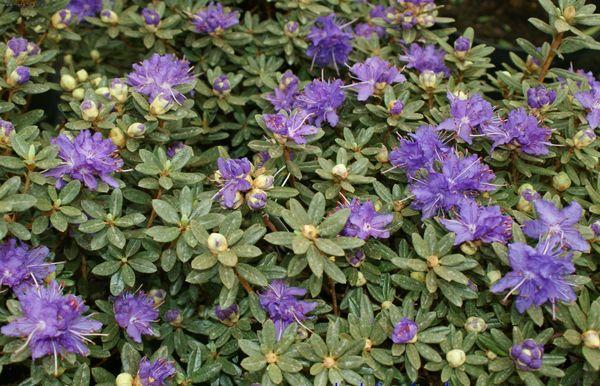
This shrub has good frost-resistant properties, but you must first mulch the soil.
Grishtede
The sub-variety Grishtede is distinguished by a pale lilac color with a slight bluish tint. The dark green leaves are small and oblong, dense structure and shiny surface. This evergreen shrub has a compact and dense crown.
The flowering period begins in summer. Grishtede's flowers are small but numerous. This sub-variety has an average frost resistance, and therefore needs soil mulching and additional cover.
Landing
In order for Rasputin's rhododendron to harden and grow well, it is important to choose the right place and prepare the soil, as well as observe a certain planting pattern.
Seat selection
The ideal place for planting the Rasputin rhododendron is quiet, semi-shady and protected from drafts. The shrub feels very comfortable under high hedges and coniferous trees.
Too shaded areas should be avoided, since the flowering period of the shrub will be somewhat late, and the flowers themselves are not large and dense enough.
Planting in a sunny place is acceptable, but in this case, more intensive watering is required. Stagnant moisture is detrimental to the shrub, therefore, a water runoff must be formed in advance.
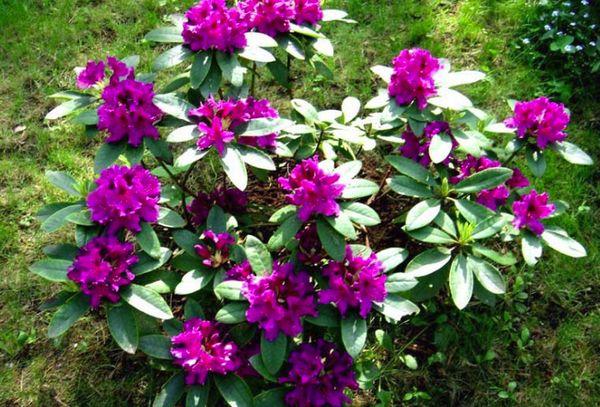
Soil preparation
Mandatory soil requirements for a rhododendron are comfortable moisture, good drainage and a sufficient amount of fertilizer. Moreover, it can be both acidic and neutral. The optimum is a soil consisting of equal parts of high sour peat, loam (garden soil) and pine litter.
Pit preparation and planting scheme
Before planting, you need to immerse a container with a seedling in water for 20 minutes to get a good soak. At this time, you can start digging a hole - its depth should be 50-60 centimeters.
Next, you need to act according to the following scheme:
- At the bottom of the pit, lay a drainage layer consisting of sawdust, pebbles and rubble.
- Pour half of the prepared soil with a slide.
- Gently spread the roots of the bush and place it strictly vertically in the hole.
- Pour the rest of the soil up to the root collar.
- Slightly compact the substrate.
- Water the seedling abundantly.
- Make a 5-centimeter layer of mulch from pine needles and sawdust.
The planted bushes must be protected from direct sunlight.
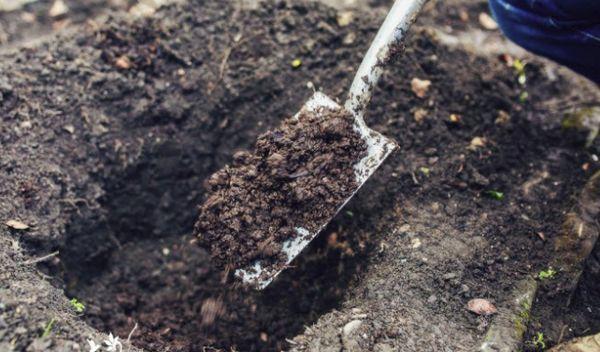
Care
For rhododendron Rasputin to grow beautiful and healthy, you need to properly care for it, ensure regular watering and add nutritious mineral supplements.
Watering
The abundance and frequency of watering depends on the season.
In the summer heat, Rasputin's rhododendron should be watered regularly, but in moderation. Each bush requires 1 bucket of water 1-2 times a week. In conditions of maximum heat, the plant must be additionally sprayed daily.
Before the onset of the first winter frosts, the shrub needs abundant watering. In winter, this procedure must be shortened and carried out exclusively in dry weather.
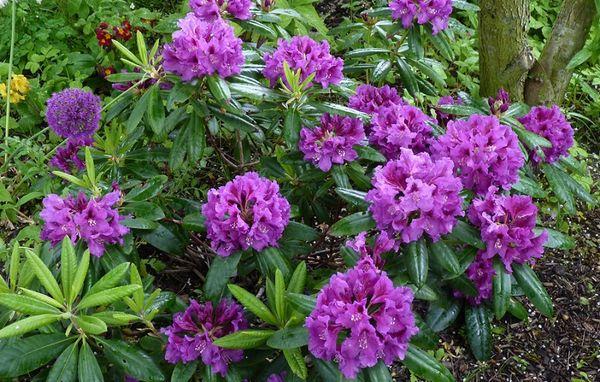
Top dressing
Rhododendron needs mineral feeding.Well-rotted manure is an affordable alternative. Do not use any fertilizers that contain chlorine or lime.
Pruning
In order for future shoots of rhododendron to develop fully, you need to regularly cut dry flowers.At the end of the flowering period, pruning of damaged and dried stems is carried out for sanitary purposes. And excess growth of rhizomes must be removed in June.
Transfer
Shrub transplant is carried out in late March or early April. It is recommended to do this at least three weeks before flowering. In order for the bush to take root better, it is necessary to remove all the buds in the first year after transplanting, since the plant can weaken under the load of abundant flowering.
Protection against diseases and pests
The most common problems of rhododendron are mites, bed bugs, and fungus. There are ways to protect against each of these phenomena.
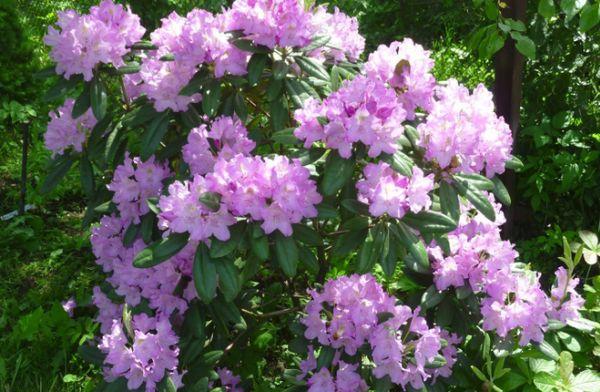
Fungal infections are the result of excessive watering and stagnant water. Thorough cleaning of the bush from damaged leaves and shoots, followed by spraying with Bordeaux liquid, will help to get rid of the disease. Bedbugs and ticks can be collected by hand or sprayed with a soap and tobacco mixture.
If a shrub is affected by a spider mite, first of all, it is necessary to carefully cut off the areas with the greatest damage, and then treat with "Karbofos" or soapy water.
Preparing for winter
Rhododendron Rasputin has good frost resistance, but additional shelter for the winter period does not hurt. You can use regular burlap or coniferous spruce branches.
Bloom
To make the flowering abundant, take into account the following features of the rhododendron.
Timing and features
The shrub is characterized by a very dense, lush and abundant flowering that begins around May-June. Rasputin rhododendron flowers are large with beautiful and expressive purple hues.
Care before and after
During the formation of buds and buds, it is necessary to ensure the optimal regime - the air temperature should not exceed 15 degrees. During flowering, the shrub needs abundant watering and sufficient lighting. At the end of flowering, you should immediately cut off wilting inflorescences.
If buds do not appear
In the absence of buds, it is necessary to carefully examine the shrub for diseases or pests that create an obstacle to flowering.
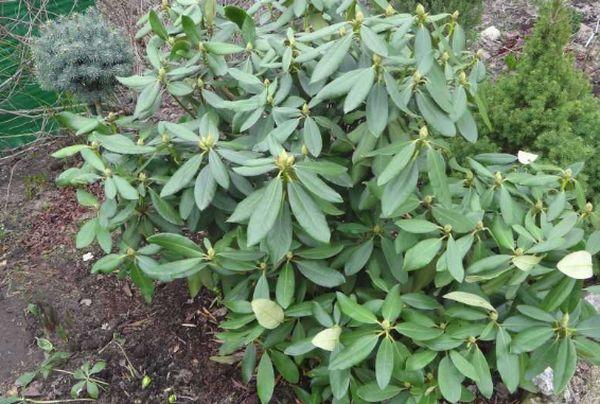
It can also be caused by a lack of moisture or minerals in the soil. In the first case, you need to adjust the frequency and intensity of watering, and in the second, fertilize with superphosphate.
Reproduction
Reproduction of rhododendron Rasputin is carried out in August by cuttings.
The sequence of actions is as follows:
- Cut off cuttings up to 5-7 centimeters long from young upper shoots.
- Remove buds and leaves.
- In the lower part of the cutting, cut off the bark and treat with a substance that stimulates root growth.
- Deepen the stalk 2 centimeters into the soil.
- Press the substrate firmly on the side.
- Moisten the soil.
- Cover the seedlings with foil and place in a shaded place.
- Ensure the air temperature does not exceed 8 ° С and ventilate the room 2-3 times every day.
A month later, under such conditions, the seedlings will take root. They can be transplanted into open ground after wintering.
Use in landscape design
Rhododendron Rasputin is often found in parks, gardens, central alleys. In both single and combined plantings, this is a true natural decoration.
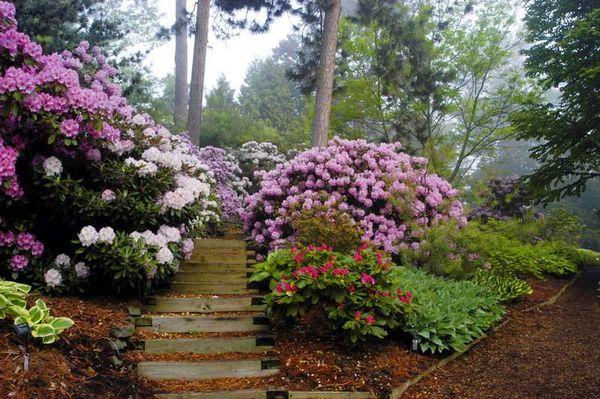
It looks very impressive in landscape compositions in combination with other varieties of evergreen rhododendrons - in particular, Caucasian, Golden and Daurian.
Problem prevention
To reduce the likelihood of bush problems, simple preventive measures must be followed.
To prevent rotting and fungal infections, the shrub should be sprayed with a solution of Fundazole or preparations containing copper twice a season.
The yellowing of the leaves indicates a decrease in soil acidity. It is necessary to add a special acidifier to the water for irrigation. Since this plant has a superficial root system, it is necessary to loosen the soil while weeding weeds so as not to accidentally damage the root.
Reviews
Karina: “Among the Rasputin rhododendron subspecies, I was attracted by Azurika. The bushes are relatively short, making them suitable for an alpine slide. I decided not to combine it with other shrubs and flowers, but simply decorated the surrounding space with oval stones. It turned out to be a wonderful place to relax. "
Valentina: “Near my house I have an alley of rhododendrons. For this I chose Boleslav the Brave - the tallest and frost-resistant subspecies of the rhododendron Rasputin. I really like the unpretentiousness of these shrubs and the ease of care. "
